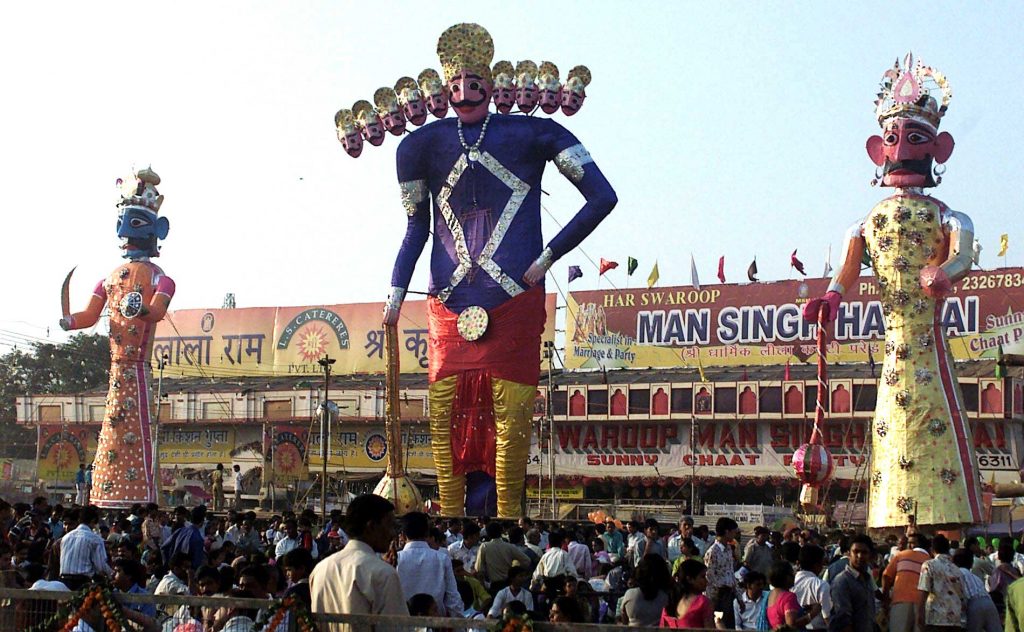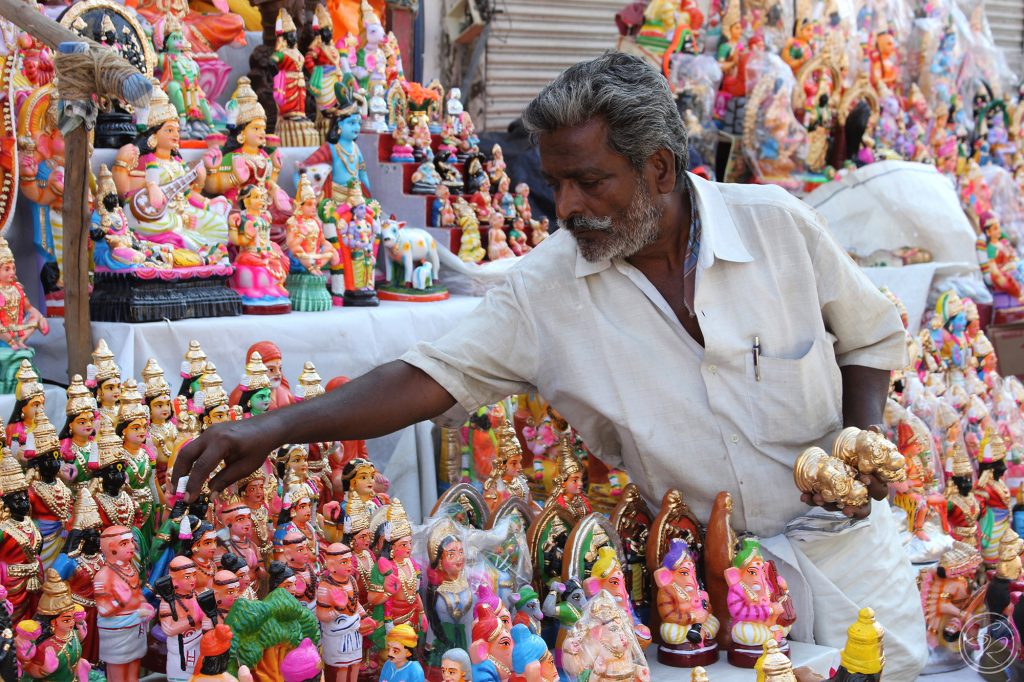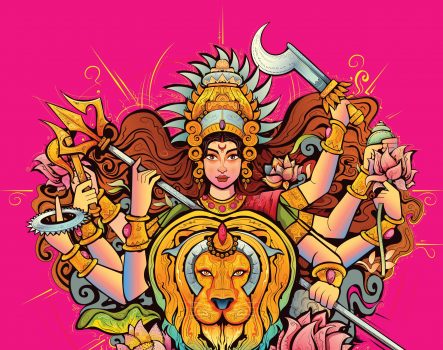Navaratri is celebrated universally by Hindus, and the events around the festivities are captured to appeal to our senses. Meera J Pillai takes you on a journey through the beauty of the nine-day festival that is celebrated annually in September/October
 Splashes of colour, sumptuous food, stories that evoke bravery and righteousness, all these encapsulate Navaratri. Although the festivities may be celebrated differently across the country, the focus is the same – triumph of good over evil. A story as old as time.
Splashes of colour, sumptuous food, stories that evoke bravery and righteousness, all these encapsulate Navaratri. Although the festivities may be celebrated differently across the country, the focus is the same – triumph of good over evil. A story as old as time.
The word Navaratri refers to the auspicious ‘nine nights’ that tell the tale of the larger-than-life battle between Goddess Shakti and the buffalo demon Mahishasura. The celebrations largely showcase plays based on the story, traditional dances, gathering of family and friends, and lavish settings. Exchanging of gifts is also a key part of the celebration.
Each region follows its own traditions. A perfect example would be in Maharashtra, where it is considered a promising time to buy property or make business deals. Married women believe that it is good fortune to invite other women and apply haldi and kumkum, both made with the versatile turmeric, on their forehead.
Even when it comes to food, there are different approaches from community to community. Some prefer to observe a strict fast, while others revel in delightful feasting. During the nine days, many exclude non-vegetarian food as well as onion and garlic from their diet. Mouth-watering dishes like khichdi, kheer, varieties of sundal and aloo-poori are commonly served during the festival.
With a large number of Indian settlements abroad, even in countries like the United States, Australia and Singapore, various associations conduct extravagant pujas, get-togethers and dance and food festivals during Navaratri.
Durga Puja
In most of the north-eastern states, Durga Puja takes precedence above everything else. During this period, the Goddess is believed to have nine different incarnations and each deity signifies a distinct power. It concludes with the celebration of the epic battle between Goddess Durga and Mahishasura, and how she emerges victorious to restore justice in the world. In Kolkata especially, Bengalis take pride in putting up elaborate pandals to house the Goddess, where pujas are carried out on the nine days.
The idols are made by artisans who toil for days together to deliver the final product. Many of them use environmentally friendly materials such as bamboo and clay to make the stunning sculptures. These are then displayed on decorated podiums in the puja pandals. On the final day, Vijayadashami, the statues are immersed in a water body.
Dussehra
In the northern and many of the western states, a dramatic re-enactment of God Rama’s life, leading to the battle and victory over the demon King Ravana, takes the centre stage. The festivities come to an end on Dussehra, when a giant effigy of Ravana is burnt typically with fireworks, marking the destruction of evil.
In Karnataka, where Navaratri is referred to as Dasara, the celebrations mostly take place during the nine nights when dances and dramas from ancient Hindu scriptures are enacted. Ironically, the city of Mysore has derived its name from Mahishasura. Therefore, the Mysore Dasara is conducted with great pomp. On Vijayadashami, several exhibitions and fairs are held all over the city as part of the celebrations.
 Garbha/Dandiya-ras
Garbha/Dandiya-ras
One of the best known celebrations during the Navaratri festival is Garbha or Dandiya-ras. This dance is performed traditionally in a circle. Originated in Gujarat, it has now become one of the most celebrated Indian dance forms. This graceful dance involves the women dressed in traditional ghagara-choli and men in kafni pyjamas and kurtas. Decorated bamboo sticks known as dandiyas are used as props when they dance in a rhythmic manner. It is mostly performed either around a pot containing a lamp or in front of a statue of Goddess Shakti. The word Garbha means womb, and in the context of the dance, the lamp in the pot metaphorically represents life.
Golu
In the South, in Tamil Nadu, Andhra Pradesh, Telangana and Karnataka, Golu or Kolu represents not just the religious aspect but the cultural and agricultural side as well. It is a colourful display of dolls mounted on odd-numbered makeshift tiers or padis. The dolls are mostly made of clay and local materials and painted in bright colours. Many of the dolls are passed on through the generations, to which collection something new is added every year. Young girls and women display these dolls in their homes through Navaratri, depicting everyday scenes along with stories based on Goddesses Saraswati, Parvathi and Lakshmi.
An important part of Golu is the social aspect, where guests are invited to see the display, share the day’s food preparation and partake in singing devotional songs.
 Pujavaipu/Vidyarambham
Pujavaipu/Vidyarambham
In Kerala, Navaratri is considered to be a good time to start something new, especially with respect to education. In tune with the same, the last three days of the festival is dedicated to worshipping Goddess Saraswati, deity of learning. Study and work materials are placed next to her statue in homes and temples. Pujavaipu is performed on Ayudha Puja day when all studies and work are suspended.
For the elaborate pujas performed to the Goddess, flowers, a selection of fruits, puffed rice, paddy and jaggery are offered. On the final day, Vijayadashami, the books and other work-related equipment are removed, and this ceremony is called Puja Eduppu. At this auspicious moment, a small ceremony with young children is carried out where they are made to write the first few Malayalam alphabets on grains of rice. It is a way to introduce them to the world of knowledge. In another ceremony, ‘Hari Sri Ganapathaye Namah’ is written with a piece of gold on the tongue of children below 5 years. This is done by either a teacher or a senior person in their family.
Navaratri also starts the preparation for one of the more important and widely notable festivals, Deepavali. The festival of lights is celebrated twenty days after Vijayadashami or Dussehra.
Just like the people in the country, the festivals and revelries surrounding it showcase a wide range of diversity. That said, the crux of it is the same. Letting justice prevail and celebrating all that is good in the world.
